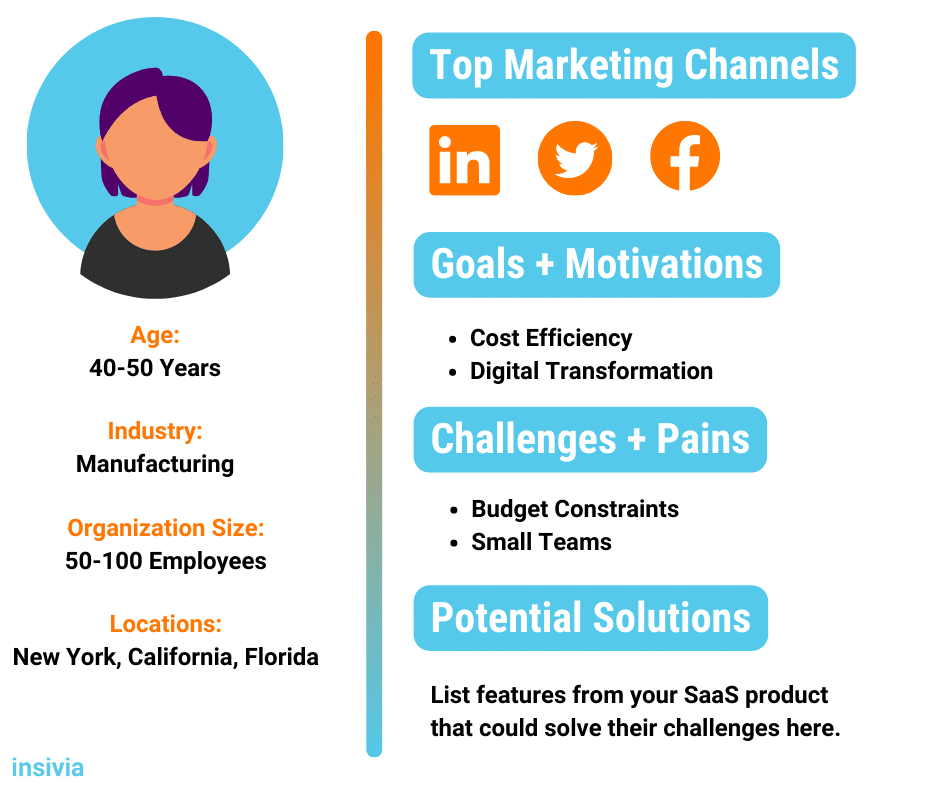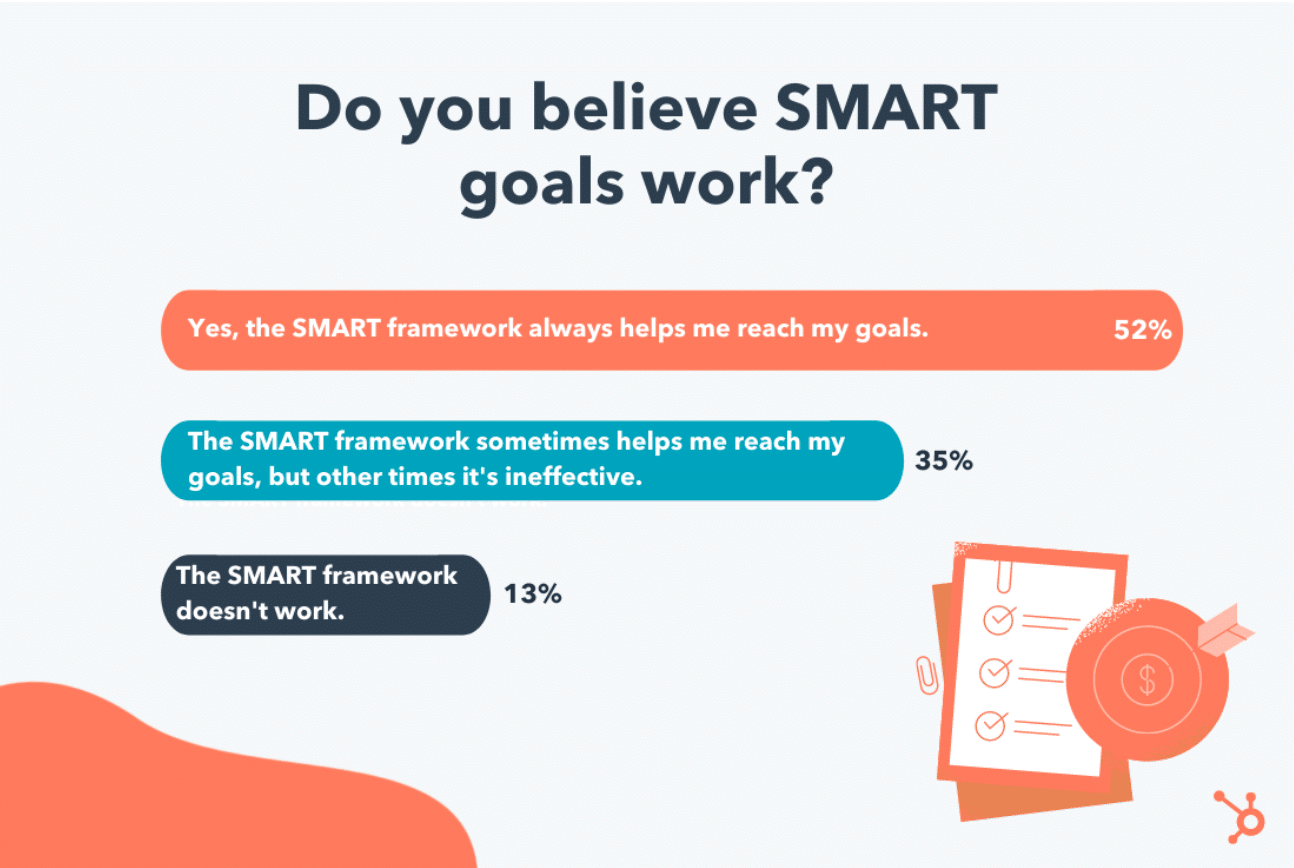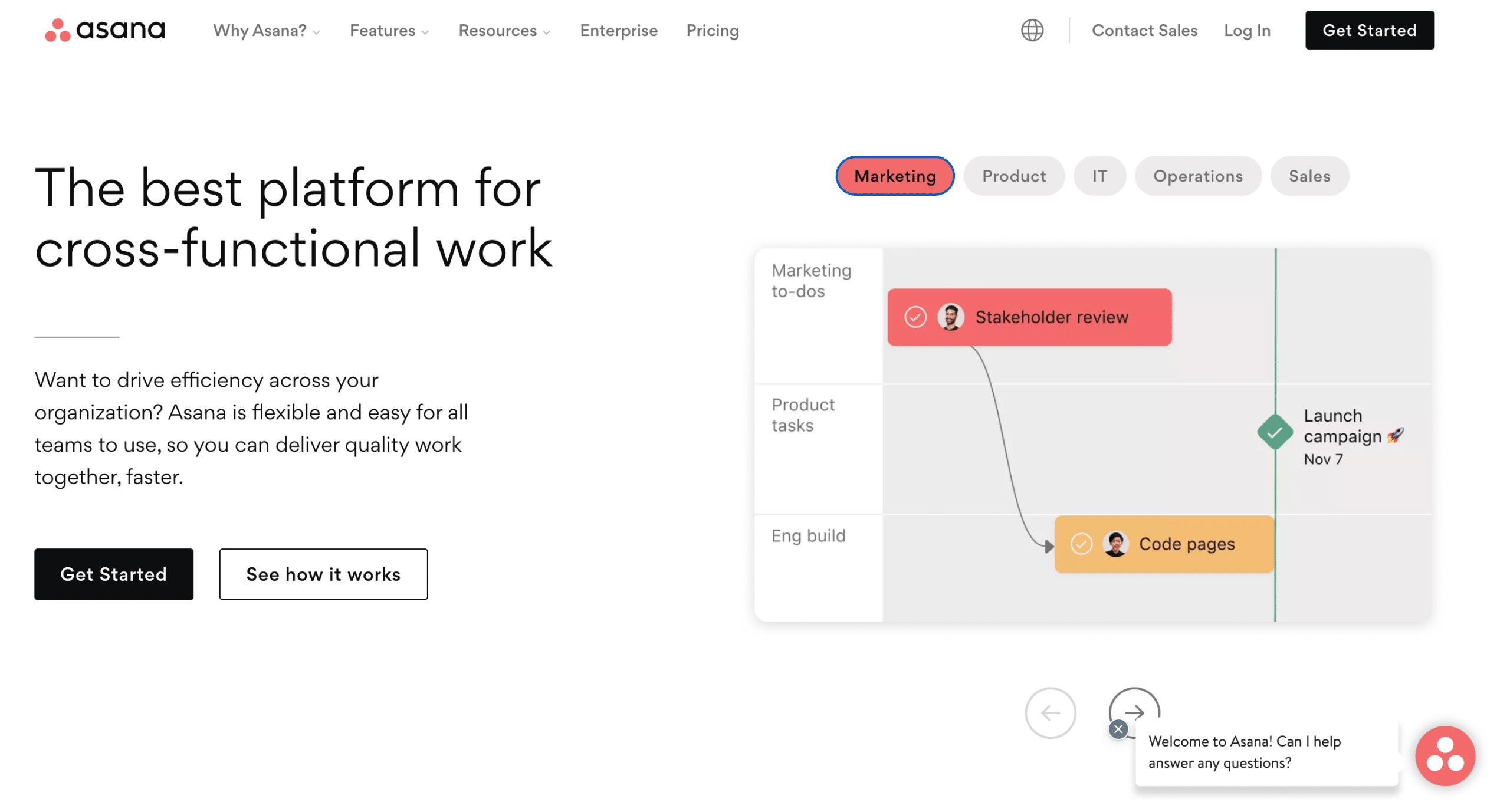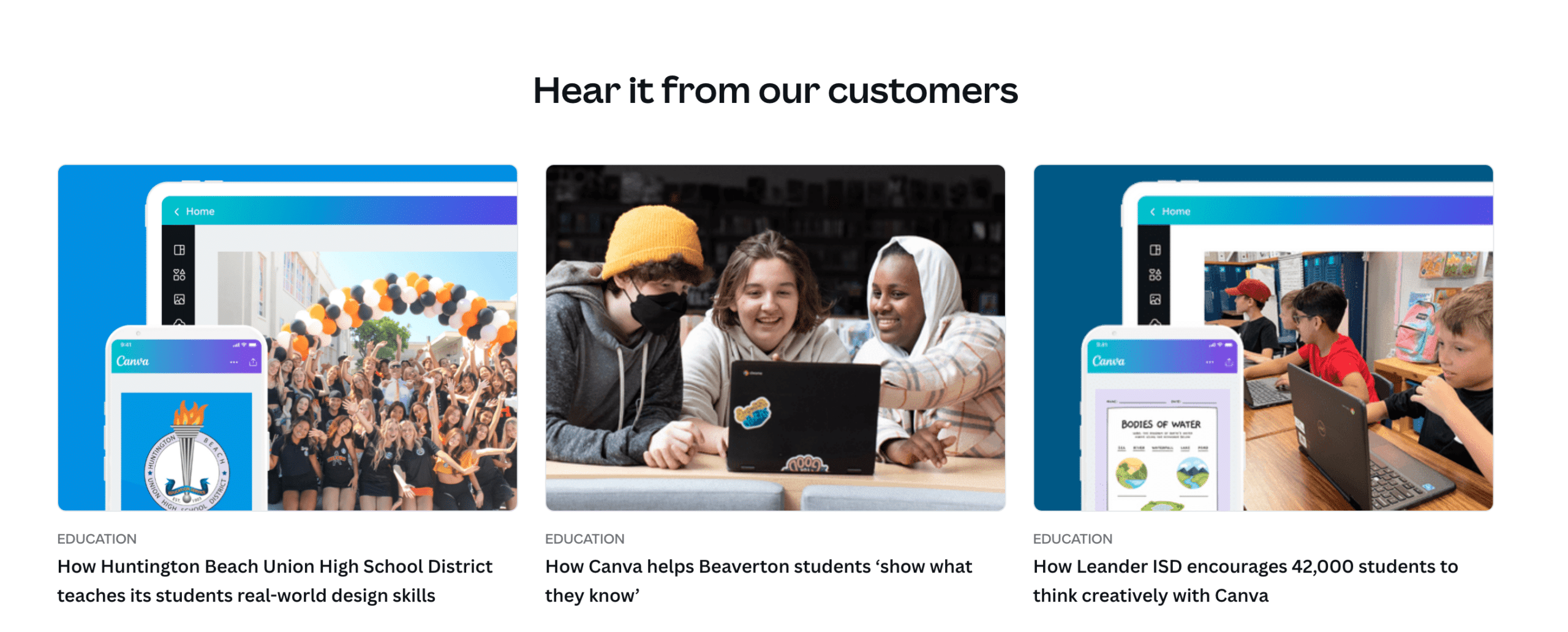Before thinking of executing a powerful marketing approach, you first need to strategize it . It would be best if you first come up with a strategic SaaS marketing strategy that you put careful analysis and evaluation on.
Let’s jump into the proactive steps you need to take to fully develop an effective marketing plan.
Step 1: Conduct Market Research & Analysis
Identify Target Buyer Personas
One of the fundamental pillars of a successful software marketing strategy is identifying and understanding the target audience and buyer personas. Without a clear grasp of who the products or services are meant for, it becomes challenging to craft compelling marketing messages and deliver them through the right channels.
To begin the process, you need to conduct comprehensive research to identify your business’s primary target audience. This involves gathering demographic information, such as:
- Age
- Gender
- Location
- Occupation
- Psychographic data, including interests, preferences, and behaviors.
- Their pain points; what problem are you solving for them?
It’s best to analyze existing customer data, conduct surveys, and employ social listening tools. These are effective methods to gain insights into the potential customer’s characteristics.
In addition to identifying the target audience, creating buyer personas is equally crucial. Buyer personas are fictional representations of the ideal customers, helping marketing teams understand their motivations, pain points, and purchasing behavior. By developing detailed buyer personas, companies can tailor their marketing strategies to address the specific needs and preferences of different customer segments.
Here’s an example of a buyer persona:

Insivia has even created an AI persona builder that you can utilize to streamline the process of identifying your ideal customer profiles.
Analyze Market Trends
Once the target audience and buyer personas have been established, it is essential to analyze the broader market landscape. This involves examining market trends, industry developments, and emerging technologies that may impact the SaaS and technology sector. Keeping a close eye on market shifts allows companies to position their offerings more effectively and stay ahead of the competition.
It’s also essential to conduct a thorough competitor analysis. Understanding the strengths and weaknesses of competitors helps you identify gaps in the market and refine your unique value proposition. By learning from competitors’ successes and failures, businesses can fine-tune their marketing approach to stand out in a crowded marketplace.
Step 2: Define Clear SaaS Marketing Objectives
Set SMART Goals
Once you’ve gained valuable insights from market research, the next crucial step is to establish clear and SMART marketing objectives. SMART goals are specific, measurable, achievable, relevant, and time-bound. This provides a roadmap for the marketing team to work toward a common purpose.
- Specific: Marketing objectives should be precise and well-defined. Rather than vague statements like “increase sales,” a specific goal would be “increase software subscriptions by 20% in the next quarter” .
- Measurable: Having quantifiable metrics to measure progress is essential. This enables companies to track their marketing performance accurately and make data-driven decisions. For example, “generate 500 leads per month through content marketing efforts” is the perfect tangible metric to follow.
- Achievable: While ambitious goals are desirable, they must also be realistic and attainable. Setting unattainable objectives may demotivate the marketing team. Striking the right balance between challenge and achievability is crucial.
- Relevant: Marketing objectives should align with the overall business strategy and contribute directly to the company’s growth and success. Every goal should have a clear purpose and impact on the organization’s bottom line.
- Time-bound: Setting a deadline for achieving the goals creates a sense of urgency and helps in monitoring progress effectively. For instance, a goal may be, “Increase website traffic by 30% in the next six months” .
In fact, Hubspot found that 52% believe SMART goals help them achieve their goals more often than if they didn’t use a SMART framework:

While your business may have a multitude of marketing objectives in mind, you need to prioritize based on growth and ROI. Some objectives may directly contribute to revenue generation, while others may focus on brand awareness or customer retention.
Prioritization helps in allocating resources, budget, and efforts efficiently. Companies should identify “quick wins” that can deliver immediate results and “long-term goals” that may take more time and effort but have a substantial impact on sustained growth.
Step 3: Develop a Unique Value Proposition
In the competitive landscape of the SaaS and tech industry, having a unique value proposition is essential to stand out from the crowd. To develop a compelling value proposition, you must gain a deep understanding of your core strengths and differentiators.
For example, Asana drives home the fact that they are the best cross-functional project management platform that drives efficiency:

These statements showcase their core strengths and functionality perfectly.
In order to create an impactful value proposition, you need to address the following elements:
- Customer Benefits: Clearly outline the tangible benefits and solutions that the products or services offer to customers. Focus on how your software offerings solve specific pain points and challenges faced by the target customer base.
- Uniqueness: Emphasize what sets your software apart from competitors. Highlighting the unique features, capabilities, or approaches showcases why customers should choose your solution over others in the market.
- Clarification: Keep the value proposition simple and easy to understand. Avoid technical jargon and aim for clear, concise language that leaves no room for ambiguity.
- Emotional Appeal: Appeal to the emotions of the target audience by addressing their desires, aspirations, or concerns. Connecting on an emotional level makes the value proposition more memorable and persuasive.
- Differentiation: Make a direct comparison with competitors to illustrate the distinct advantages of the company’s offerings. Showcase why customers should choose your products or services over others.
Once established, your value proposition should be prominent throughout your content. This includes your website, social media posts, email marketing, and advertising campaigns. It should be at the core of marketing materials, clearly visible on the company’s website, and be an integral part of sales pitches and presentations.
Step 4: Choose the Right Marketing Channels For Your SaaS Marketing Strategy
Each marketing channel offers unique strengths and advantages, making it crucial for companies to carefully evaluate and select the most appropriate ones for their SaaS marketing strategy.
- Social Media: Social media platforms provide an excellent avenue for building brand awareness, engaging with the audience, and driving traffic to the company’s website. You should consider the demographics of each platform and select the ones where their target audience is most active.
- Content Marketing: Content marketing is a powerful tool for establishing thought leadership and showcasing your expertise. Leverage blogs, whitepapers, videos, and other content formats to provide valuable insights, solve customer problems, and generate leads.
- Email Marketing: Email marketing remains a highly effective channel for nurturing leads, promoting new products, and engaging with existing customers. Get ahead of the game with personalized messaging as 49% of marketers don’t customize their emails for their target personas. Personalized and relevant email campaigns can drive conversions and foster long-term customer loyalty.
- Search Engine Optimization (SEO): Ranking high on search engine results is vital for attracting organic traffic to your website. A well-executed SEO strategy ensures that your offerings are easily discoverable by potential customers.
How Do You Narrow Down?
Choosing the right marketing channels should be driven by a deep understanding of the target audience’s preferences and behavior. Companies must research where their potential customers spend their time, how they consume information, and what influences their purchasing decisions.
For instance, if the target consumers are comprised of tech-savvy professionals, they might be more active on LinkedIn, making it a suitable platform for B2B marketing. Conversely, if the target market is primarily consumers, platforms like Instagram or TikTok might be more effective for reaching them.
Offline Marketing Remains Effective
Attending industry conferences and trade shows can still be a lucrative SaaS marketing strategy. This allows companies to interact with potential customers face-to-face, build relationships, and showcase expertise. Business cards and brochures distributed at such events can also drive recipients to your website or social media profiles.
Additionally, traditional advertising in relevant publications or sponsoring local events can enhance brand visibility within targeted geographic areas. This can work synergistically with online advertising and social media campaigns to create a comprehensive software marketing approach.
Step 5: Craft Informative & Authoritative Content
When customers perceive a company as a thought leader, they are more likely to seek out its products or services and trust its recommendations. Thought leadership not only fosters customer loyalty but also attracts potential partners, investors, and media attention, thereby boosting your company’s overall reputation.
Diverse audiences have varying preferences for consuming content. Some prefer reading detailed blog posts, while others are more engaged with video content. To cater to a wide range of audience preferences, you should incorporate different content formats into your SaaS marketing strategy:
Blogs & Articles
Well-written blog posts and articles provide an opportunity to delve into complex topics, share industry insights, and address customer pain points. They are also valuable for search engine optimization, driving organic traffic to the company’s website.
Videos
Video content is highly engaging and can effectively explain complex concepts or demonstrate software features. You can create product demos, explainer videos, webinars, and tutorials to educate and connect with your audience visually.
eBooks & Guides
In-depth eBooks and comprehensive guides offer customers valuable resources that they can download and reference. These longer-form content pieces can delve into complex topics and provide in-depth solutions to customer challenges.
Infographics
Infographics are visually appealing and an effective way to present data, statistics, or complex information in a concise and easily digestible format.
Podcasts
For audiences who prefer audio content, podcasts are an excellent way to share valuable insights, industry trends, and interviews with experts.
Step 6: Implement Data-Driven Marketing Techniques
Through tools like Google Analytics, social media analytics, and marketing automation platforms, companies can track metrics such as website traffic, conversion rates, bounce rates, click-through rates, and engagement levels across different marketing channels.
Analyzing this data allows you to identify which marketing initiatives are delivering the best results and which ones may need improvement. It also provides visibility into the customer journey, helping companies optimize their marketing funnel and enhance the user experience.
Track KPIs
To effectively measure the success of marketing campaigns, SaaS and tech companies must identify and track key performance indicators (KPIs). KPIs are quantifiable metrics that align with specific marketing objectives and provide clear insights into the performance of a campaign.
The choice of KPIs may vary based on the nature of the marketing campaign. For example, KPIs for a lead generation campaign may include the number of leads generated, cost per lead, and conversion rate. Alternatively, a content marketing campaign may focus on metrics like page views, time on page, and lead generation from content.
Data-driven marketing extends beyond just collecting and analyzing data; it also involves making strategic decisions based on the insights obtained. Companies should actively use the data to optimize their marketing efforts and drive continuous improvement. For example, you can execute this by conducting A/B testing with your content. This would involve making tweaks to headings, CTAs, images, etc.
Step 7: Incorporate Social Proof & Testimonials
Prospective customers often seek assurance that a product or service can deliver on its promises. This is very prominent as 88% of consumers trust user reviews as much as personal recommendations. Customer success stories serve as powerful testimonials, providing evidence of the company’s ability to deliver value and solve real-world issues. Additionally, they humanize your brand, making it relatable and trustworthy to potential customers.
You can actively collect and leverage positive reviews and testimonials through various channels, such as:
- Social Media
- Review Websites
- Direct Customer Feedback
Social proof, in the form of user-generated content, can significantly reinforce the value proposition of your SaaS business. When potential customers see their peers or industry leaders endorsing a product or service, they are more inclined to trust the company and consider its offerings.
Case studies are also great for showcasing success stories. Canva does a great job of this with their library of case studies on their website:

Step 8: Focus on Customer Experience & Engagement
SaaS businesses need to invest in user interface (UI) design that is visually appealing, user-friendly, and optimized for different devices and screen sizes. Navigation should be intuitive, allowing users to find information and access features effortlessly. Streamlining the registration and checkout processes reduces friction and enhances the user experience.
Along with your website’s content, you can create a personalized customer experience through the following:
- Email Marketing: Tailor email campaigns based on customer preferences, recommend relevant products or services based on past interactions, and use dynamic content on the website to address specific customer segments.
- Customer Support: Offering personalized responses to customer inquiries, providing proactive assistance, and anticipating customer needs demonstrates your dedication to meeting individual customer requirements.
Always Evolve Your SaaS Marketing Strategy
Continuous improvement and innovation are critical for the sustained growth and success of your SaaS business. Marketing strategies that work today may become less effective in the future due to changing market dynamics and customer preferences. Therefore, you must remain agile and open to adapting your SaaS marketing approaches in order to stay relevant and competitive.
Regularly analyzing marketing performance, listening to customer feedback, and keeping abreast of industry trends enable you to identify areas for improvement and innovation. Embracing new technologies, exploring new tactics, and refining strategies based on data-driven insights will keep you ahead of the curve and foster long-term success.
